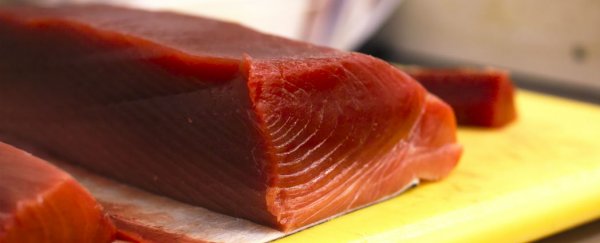It's taken them more than 30 years, but scientists in Japan have successfully bred and raised bluefin tuna in captivity - something no one else has managed to do - in an effort to save the rapidly declining wild population.
The team, from Kinki University in Wakayama, has had to overcome the many difficulties in breeding these incredibly delicious fish, because they're super-sensitive to a whole range of environmental factors, such as water temperature fluctuations, current movements, and noise pollution. Plus their large size - they can grow up to 350 kilograms - can also get them into trouble, with fasting-moving tuna-on-tuna collisions inside large farming pens sometimes ending up fatal.
But the Japanese researches have figured out how to mitigate all the dangers of keeping these fish in captivity long enough for them to be sent to market as a replacement for the wild-caught product. A four-year-old bluefin tuna bred in captivity is enough to feed about 200 people, says Matthew Carney at ABC News. They now have a farm of about 4,000 individual fish.
"The first challenge was to increase survival rates from harvested eggs to hatchlings, and we got it to 5 percent," one of the team, Yoshifumi Sawada, told him. "The bluefin hatchlings ate each other, so we then had to introduce other types of hatchling species for them to eat."
"Our mission is to supply about half of the Japanese domestic market," added Tokihiko Okada, general manager of Kinki Fisheries, who is working with the scientists to sell their fish to the pubic. "We'll need about 300,000, but we'll get there and reduce the pressure on tuna in the wild."
Not only is it an incredible achievement in its own right, to be the first team to successfully set a captive breeding program for these widely popular fish - with just as much taste and less mercury than their wild counterparts - but the scientists have come up with a way to make money from it, which they say will be funnelled right back into their research.
"As well as mastering the technology to ensure sustainable bluefin supplies, the scientists at Kinki University have developed a business model in which they own the restaurants the tuna are sent to. The profits they make at the restaurants then fund future research and development for bluefin tuna."
The team is now working on getting their farmed population up, and will conduct ongoing genetic tests to figure out which traits they should be selecting for future generations.
The development couldn't be more welcome, as global populations of bluefin tuna are dwindling due to demand from Japan, China, and other parts of Asia in particular. According to Justin McCurry at The Guardian, at the end of 2014, the International Union for Conservation of Nature bumped the Pacific bluefin tuna ranking from 'least concern' up to 'vulnerable' in the ICUN Red List of endangered species.
"The IUCN estimates the Pacific bluefin population has declined by 19 to 33 percent over the past 22 years," says McCurry, "mainly to satisfy demand for sushi and sashimi in Asia. Most of the fish caught are juveniles, making it impossible for them to reproduce."
While some Pacific nations have agreed to cut back on their farming of wild bluefin tuna, conservationists are saying the only way for the population to replenish itself to save levels is to stop fishing them altogether. Which is probably unlikely, given how lucrative these fish can be. Captive fishing might be the only way to save this impressive fish, so we hope Sawada and his team can do it.
Sources: ABC News, The Guardian
